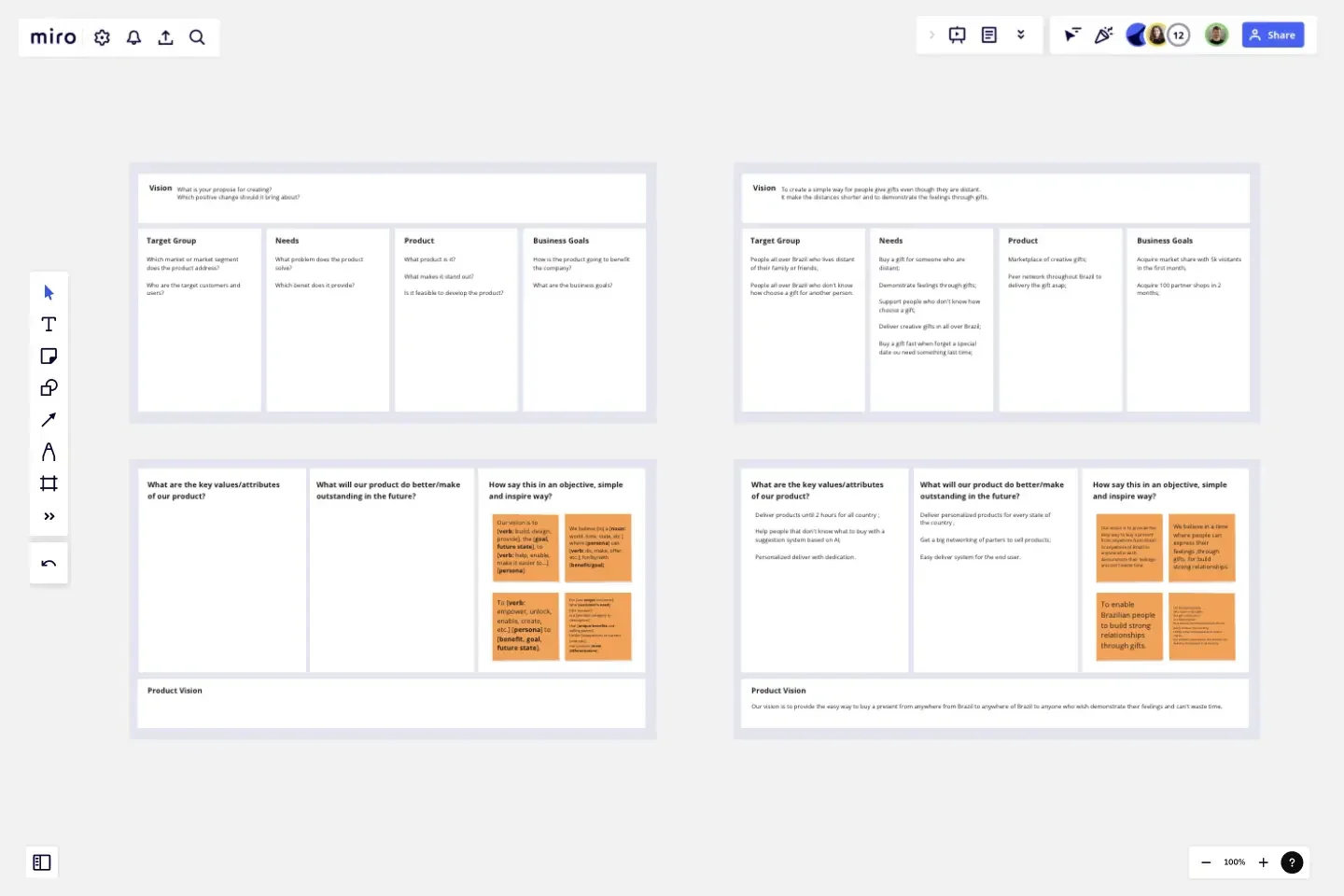Product Vision
This template is intended to help you to build the vision for your product.
Trusted by 65M+ users and leading companies
This template is divided into two steps:
Step 1 - Defining Key Product Information:
This first moment is very important for you to gather and organize the information of your product about vision, target group, needs, product, and business goals.
Step 2 - Phrasing Product Vision:
Based on the information of the first step, you will describe the key values of the product, the product's outstanding points for the future, and finally, phrase the product vision.
At the board, there are 4 product vision templates for you to choose from and create the product vision.
This template was created by Caterine Greif.
Get started with this template right now.
Timeline Template
Works best for:
Project Management, Flowcharts, Project Planning
A timeline displays a chronological order of important dates, and scheduled events. Timelines help product managers, project managers, and team members tell visual stories about progress and obstacles. Timelines enable teams to see at a glance what happened before, what progress is happening now, and what needs tackling in the future. Projects or products with specific purpose or deliverables should be based on a timeline to be successful. Use the timeline as a shared reference for start dates, end dates, and milestones.
Stakeholder Mapping Template
Works best for:
Business Management, Mapping, Workflows
A stakeholder map is a type of analysis that allows you to group people by their power and interest. Use this template to organize all of the people who have an interest in your product, project, or idea in a single visual space. This allows you to easily see who can influence your project, and how each person is related to the other. Widely used in project management, stakeholder mapping is typically performed at the beginning of a project. Doing stakeholder mapping early on will help prevent miscommunication, ensure all groups are aligned on the objectives and set expectations about outcomes and results.
Impact/Effort Matrix Template
Works best for:
Project Management, Strategic Planning, Prioritization
Growing organizations have countless to-do’s and only so many hours in a day (or weeks before a big launch) to get them done. That’s where an impact effort matrix comes in. It gives you a quick visual guide to help prioritize your tasks and know exactly what’s worth doing. Using our template, you can create a matrix that organizes your activities into four main categories: quick wins that are low effort, effort-intensive projects that provide long-term returns, fill-ins that are low effort but low value, and time-wasters.
Project Timeline Template
Works best for:
Project Management
The Project Timeline Template simplifies project management. Illustrating tasks, milestones, and deliverables on a calendar visually shows teams a project's progression. One of its standout benefits is its ability to foster clarity. With this template, project milestones are translated into an easily digestible format, enabling team members to quickly comprehend the entirety of the project's scope and sequence, thereby enhancing productivity and reducing potential misunderstandings.
Hiring Process Timeline
Works best for:
Timeline, Planning
Streamline your recruitment process with the Hiring Process Timeline by Rizwan Khawaja. This template helps you organize every step of hiring, from job advertisement to final onboarding. Visualize timelines, track candidates, and ensure an efficient hiring workflow. Perfect for HR professionals aiming to improve their recruitment strategy and reduce time-to-hire.
Communication Matrix Template
Works best for:
Project Management, Project Planning, Meetings
The Communication Matrix Template serves as a structured framework for businesses and projects to streamline their communication strategies. By mapping out types of communication, their purposes, mediums, frequencies, and intended audiences, the template ensures that every stakeholder remains informed and aligned. One of its key benefits is the enhanced clarity it brings. By laying out the specifics of each communication touchpoint, the matrix eliminates ambiguity, ensuring that all involved parties know exactly what to expect and when leading to more efficient collaboration and fewer misunderstandings.
